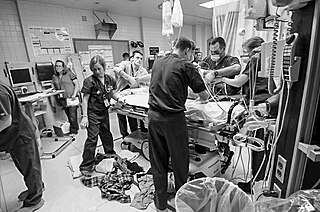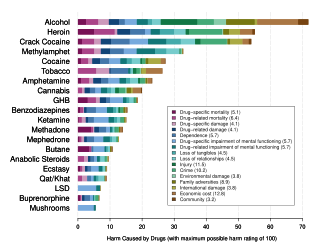
Alcohol intoxication, also known in overdose as alcohol poisoning, commonly described as drunkenness or inebriation, is the behavior and physical effects caused by a recent consumption of alcohol. In addition to the toxicity of ethanol, the main psychoactive component of alcoholic beverages, other physiological symptoms may arise from the activity of acetaldehyde, a metabolite of alcohol. These effects may not arise until hours after ingestion and may contribute to the condition colloquially known as a hangover. The term intoxication is commonly used when large amount of alcohol is consumed along with physical symptoms and deleterious health effects.

In medicine, triage is a process by which care providers such as medical professionals and those with first aid knowledge determine the order of priority for providing treatment to injured individuals and/or inform the rationing of limited supplies so that they go to those who can most benefit from it. Triage is usually relied upon when there are more injured individuals than available care providers, or when there are more injured individuals than supplies to treat them.

Emergency medicine is the medical speciality concerned with the care of illnesses or injuries requiring immediate medical attention. Emergency physicians specialize in providing care for unscheduled and undifferentiated patients of all ages. As first-line providers, in coordination with emergency medical services, they are primarily responsible for initiating resuscitation and stabilization and performing the initial investigations and interventions necessary to diagnose and treat illnesses or injuries in the acute phase. Emergency medical physicians generally practice in hospital emergency departments, pre-hospital settings via emergency medical services, and intensive care units. Still, they may also work in primary care settings such as urgent care clinics.

An emergency department (ED), also known as an accident and emergency department (A&E), emergency room (ER), emergency ward (EW) or casualty department, is a medical treatment facility specializing in emergency medicine, the acute care of patients who present without prior appointment; either by their own means or by that of an ambulance. The emergency department is usually found in a hospital or other primary care center.

Drug rehabilitation is the process of medical or psychotherapeutic treatment for dependency on psychoactive substances such as alcohol, prescription drugs, and street drugs such as cannabis, cocaine, heroin or amphetamines. The general intent is to enable the patient to confront substance dependence, if present, and stop substance misuse to avoid the psychological, legal, financial, social, and physical consequences that can be caused.Citation needed
Psychomotor agitation is a symptom in various disorders and health conditions. It is characterized by unintentional and purposeless motions and restlessness, often but not always accompanied by emotional distress. Typical manifestations include pacing around, wringing of the hands, uncontrolled tongue movement, pulling off clothing and putting it back on, and other similar actions. In more severe cases, the motions may become harmful to the individual, and may involve things such as ripping, tearing, or chewing at the skin around one's fingernails, lips, or other body parts to the point of bleeding. Psychomotor agitation is typically found in various mental disorders, especially in psychotic and mood disorders. It can be a result of drug intoxication or withdrawal. It can also be caused by severe hyponatremia. The middle-aged and the elderly are more at risk to express it.
Public intoxication, also known as "drunk and disorderly" and "drunk in public", is a summary offense in some countries rated to public cases or displays of drunkenness. Public intoxication laws vary widely by jurisdiction, but usually require an obvious display of intoxicated incompetence or behavior which disrupts public order before the charge is levied.
Alcohol exclusion laws permit insurance companies to deny claims associated with the consumption of alcohol. They were passed in the 1940s in the United States to discourage people from drinking alcoholic beverages and to save insurance companies money from alcohol-related claims. It was believed that people would be less likely to drive while impaired or intoxicated if insurance companies could deny medical payments or other claims associated with any injuries associated with the consumption of alcoholic beverages. Thirty-six states currently allow alcohol exclusions in health care insurance policies via either explicit exclusions or implicit exclusions determines by legal precedence. A growing number of states are overturning their alcohol exclusion laws, currently 14 states plus the District of Columbia prohibit insurance companies from including exclusions for alcohol intoxication.

A drunk tank is a jail cell or separate facility accommodating people who are intoxicated, especially with alcohol. Some such facilities are mobile, and may be spoken of as "booze buses".

Emergency psychiatry is the clinical application of psychiatry in emergency settings. Conditions requiring psychiatric interventions may include attempted suicide, substance abuse, depression, psychosis, violence or other rapid changes in behavior.

Droperidol is an antidopaminergic drug used as an antiemetic and as an antipsychotic. Droperidol is also often used as a rapid sedative in intensive-care treatment, and where "agitation aggression or violent behavior" are present.
Transitional living refers to any type of living situation that is transitional. The primary purpose or mission of transitional living environments is temporary. Transitional living facilities often offer low-cost housing. Transitional living residents that cater to those recovering from economic hardship often graduate from a shelter to a lesser crowded living situation. Transitional living may or may not have other common threads among residents. Transitional living provides professional support, education, and a stable living environment. Common types of transitional living include transitioning from jail or prison, an addiction treatment center or a mental health facility. They may also target homelessness, especially among youth. Transitional living is provided by many well known private and non-profit organizations, by government, churches and other charitable organizations.
Emergency ultrasound employing point-of-care ultrasound (POCUS) is the application of ultrasound at the point of care to make immediate patient-care decisions. It is performed by the health care professional caring for the injured or ill persons. This point-of-care use of ultrasound is often to evaluate an emergency medical condition, in settings such as an emergency department, critical care unit, ambulance, or combat zone.
The San Francisco Syncope Rule (SFSR) is a rule for evaluating the risk of adverse outcomes in patients presenting with fainting or syncope.
Field triage is the process by which emergency medical services providers decide on the destination for the injured subject.

Cocaine intoxication refers to the subjective, desired and adverse effects of cocaine on the mind and behavior of users. Both self-induced and involuntary cocaine intoxication have medical and legal implications.
Recovery coaching is a form of strengths-based support for people with addictions or in recovery from alcohol, other drugs, codependency, or other addictive behaviors. There are multiple models, with some programs using self-identified peers who draw from their own lived experience with substance use and recovery and some utilizing people who have no lived experience but some training in support, depending on local standards and availability. They help clients find ways to stop addiction (abstinence) or reduce harm associated with addictive behaviors. These coaches can help a client find resources for harm reduction, detox, treatment, family support and education, local or online support groups; or help a client create a change plan to recover on their own.

Alcohol, sometimes referred to by the chemical name ethanol, is a depressant drug found in fermented beverages such as beer, wine, and distilled spirit — in particular, rectified spirit. Ethanol is colloquially referred to as "alcohol" because it is the most prevalent alcohol in alcoholic beverages, but technically all alcoholic beverages contain several types of psychoactive alcohols, that are categorized as primary, secondary, or tertiary; Primary, and secondary alcohols, are oxidized to aldehydes, and ketones, respectively, while tertiary alcohols are generally resistant to oxidation; Ethanol is a primary alcohol that has unpleasant actions in the body, many of which are mediated by its toxic metabolite acetaldehyde. Less prevalent alcohols found in alcoholic beverages, are secondary, and tertiary alcohols. For example, the tertiary alcohol 2M2B which is up to 50 times more potent than ethanol and found in trace quantities in alcoholic beverages, has been synthesized and used as a designer drug. Alcoholic beverages are sometimes laced with toxic alcohols, such as methanol and isopropyl alcohol. A mild, brief exposure to isopropyl alcohol is unlikely to cause any serious harm, but many methanol poisoning incidents have occurred through history, since methanol is lethal even in small quantities, as little as 10–15 milliliters. Ethanol is used to treat methanol and ethylene glycol toxicity.

A managed alcohol program is a program meant to reduce harm for chronic alcoholics. The program involves providing a regular dose of alcohol to individuals with alcohol addiction, typically at a shelter-based harm reduction centre.
Stroke centers are medical centers having health professionals specially trained in emergency stroke care. They are considered preferred first responders in the diagnosis and treatment of strokes. Certifying authorities recognize four levels of certification, highest to lowest, as follow:









